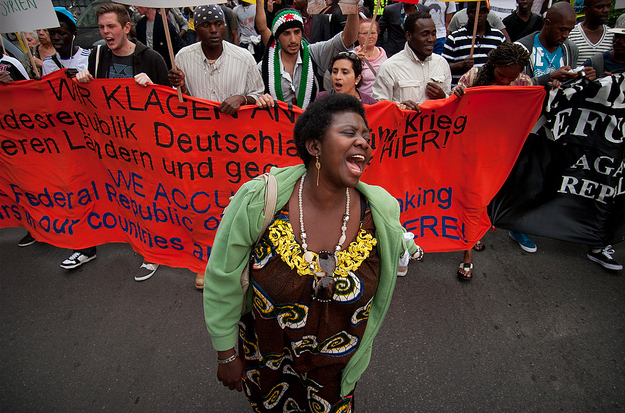In the Dogon country of Mali, something astonishing is happening. In a dozen villages northeast of Koro, facing the hot Sahara desert, food is in plentiful supply, despite the drought affecting the region. Dogon farmers reaped a bumper crop a year ago, ensuring their villages would have enough food to carry them through the dry season.
Elsewhere in the Sahel, a catastrophe is brewing. Across the swathe of arid lands between the Atlantic and the Red Sea, malnutrition is raging. Famine has already hit every nation from Mali and Burkina Faso in the west to Sudan and Kenya in the east.
I found out about this completely underreported bit of news while spending time with the global institute tasked with the management and improvement of trees used in tropical farming – for food, fuel, fodder, and more. At Nairobi’s World Agroforestry Centre, over 500 scientists devote their careers to improve our understanding of the role of trees in farming.
I have learnt that it is not primarily the drought affecting these lands that is to blame. They have always been arid, and their farmers have traditionally coped with these conditions. Something far more serious, and far more scary, is afoot: the soil is dying.
Exhausted of organic matter, baked hard by the relentless sun, the soils of the Sahel are barely able to support crops any longer. When rain does come, it washes off the hard, concrete-like surface in flash floods, barely moistening the soil underneath. Yields are dropping, even in years of good rain.
For centuries, African dryland farmers dealt with their harsh environment by fallowing, letting land lie idle for up to 15 years to benefit from the organic matter generated by natural vegetation. But population growth means that there is no spare land any more. Fallow periods have dropped to two years or less, with the land being cropped every year in a desperate attempt to grow enough food for all. That option is exhausted. Animal manure, a time-honoured way of boosting the fertility of crop lands, has become scarce, too: there is simply not enough grazing land left.
And right as these traditional fertility methods are failing, the oil-dependent price of chemical fertilisers is soaring. With global oil demand growing rapidly, this is unlikely to change. A serious catastrophe is in the making.
Research carried out by renowned agroecologist Roland Bunch and published in this year’s “state of the planet” report shows that across an area of drylands that hosts 150 million rural farmers, yields are dropping by 10 to 15% every year as soils are dying. A perfect storm of adversity is beginning to impact some of the poorest people on the planet.
There are grounds to fear the worst: Bunch fears that 50 million people could be at risk of starvation by 2015. If he is right, desperate millions will flood the slums of Africa’s cities and the smugglers’ routes to Europe. As more rural poor crowd the cities, the price for their largely unskilled labor will drop just as food prices continue to surge thanks to collapsing agricultural productivity. Starvation will begin stalking the slums, too. A deadly cycle of famine and political instability will take root.
He may well be right, sadly. I found plenty of people at the agroforestry centre willing to question details of his analysis. But they all agree with his central tenet: the decline in soil fertility across Africa’s drylands is evident, driven by population and climate change, and deeply worrying.
But the Dogon country shows it need not be so. The Dogon farmers near Koro are living in the same drylands as their neighbours. They, too, have to deal with scarce rains. And, like them, they have no money to buy fertilisers. Yet their fields yield many times more food than their neighbours’. Their malnutrition rates are much lower. What is going on?
What the Dogons are doing is a traditional form of multi-story agriculture, or agriculture with trees. The native species they use fertilise the soil as their small leaves drop – unusually, at the start of the rainy season, just when crop seedlings need all the help they can get. Their burrowing roots bring up precious nutrients and water from many meters down, nourishing the land and helping it keep some moisture even during droughts. And when it comes time to harvest, farmers leave the residues on the soil, protecting it from wind and sun.
Their soft and loamy soils are a sharp constraint to the surrounding plains of rock-hard ground. These absorb twice as much water when the rains come. And the trees provide fodder for livestock, fuel for cooking fires, timber for construction, and nuts and medicinal bark for sale. While their neighbours are at constant risk of starvation, for these Dogon farmers, that threat is remote.
This kind of agriculture, known as evergreen cultivation because the soil is never left bare, has been pioneered across Africa’s drylands by the World Agroforestry Centre. It has proven itself elsewhere. In Malawi, where it has been applied by over 200,000 farmers, yields have risen dramatically, and the soil is healing. The districts where it is used, recipients of food aid a few years ago, have now become net food exporters.
The government now intends to roll evergreen agriculture out across the country. Ethiopia has announced a massive programme to plant 100 million fertiliser trees. Tanzania, Rwanda and others have adopted national agroforestry strategies, too. In parts of Kenya, the land is beginning to look like that of the Dogon, more like a forest than like traditional farmland. And here in Zimbabwe, where I am writing these words, the demand for this technology is far outstripping the supply of fertiliser tree seeds.
It takes very little to set up this kind of agriculture: tree seeds and a bit of planting. There is no need to buy unaffordable inputs. Often, all it takes for evergreen methods to spread is for farmers to see their neighbours benefiting from their use. In Niger, Zambia, Burkina Faso, Tanzania and elsewhere, pockets of evergreen agriculture are spreading, protecting their farmers from famine.
Evergreen agriculture can double or triple crop yields. The best farmers get yields of up to 7 tons – almost as much as the American Midwest’s average of about 10 tons. The trees capture atmospheric carbon; help farmers better cope with droughts and heavy rains; and do it all while reversing decades of soil degradation. Growing food this way is the future – because it works.
But Africa’s drylands are vast. Different tree and crop combinations are needed to meet given local conditions. Transport is nonexistent or very expensive, and there are few radios and fewer TVs. Most farmers don’t know that there is a practical solution to reverse the slow death of their soils, and have no access to the necessary tree seeds.
And it takes time for trees to grow – time that we are rapidly running out of. The dramatic drop in soil fertility that Bunch has documented has already led tens of millions of people to the edge of starvation. One more drought, even a moderate one, will push them over that edge.
The catastrophe can be avoided, but there is no time to lose. Evergreen agriculture must be rolled out as rapidly as possible, across all of Africa’s drylands.
Such a programme need not be expensive. Growing the necessary seeds can be good business, as Malawi’s tree seed producers attest. Sometimes, it is enough to fund a vehicle whose job it is to carry farmers to a nearby evergreen farm. Evergreen advisors can help establish the first farms in a new area, selecting appropriate seeds and helping the village agree bylaws to protect young seedlings from animals. That seed of incentive will, experience shows, help convince the neighbours.
Evergreen agriculture will spread. The expertise to carry out evergreen across the continent is already available. It must be deployed, and now. It is the only proven, sustainable method to avoid a looming catastrophe of almost unimaginable scale.
Photograph courtesy of SOS Sahel UK. Published under a Creative Commons license.





